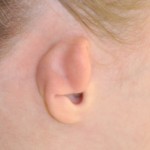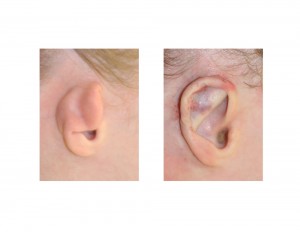The shape of the ear is incredibly complex and it is a miracle that the ear is properly formed as often as it does. But when it does not become adequately shaped there are many possibilities for its deformity. One such category of congenital ear deformity is that of the constricted ear. This is where the outer rim of the ear is smaller than it should be or tightened…much like that of a cinch around a waistband.

While the lop ear can be easily folded back up into an upright position manually, it will not so easily stay that way for it lacks structural support to remain so. Thus simple cartilage suturing, like that in a setback otoplasty (ear pinning), will not usually work or will only have short term shape retention. Cartilage grafting is usually need to provide the support or ‘framework’ for ear shape retention.

The severe lop ear deformity is best reconstructed with a small rib graft. This ensures the ear will heal in an upright position without risk of a recurrent fold over due to inadequate cartilage support.
Dr. Barry Eppley
Indianapolis, Indiana



